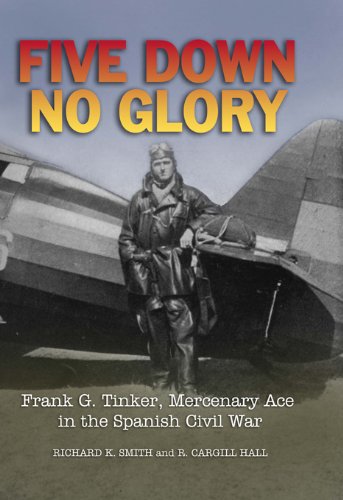OT for AoJ but the 2016 (edition) Naval Institute Press book 'Five Down No Glory' is an exceptionally well written and interesting account of 'Frank G. Tinker, Mercenary Ace in the Spanish Civil War' by Richard K. Smith and R.Cargill Hall. Tinker, (1909- 1939) a former US Navy and US Army officer, flew the Polikarpov I-15 and I-16 for the Republican cause in Spain, so perhaps a tenuous link to interests here are the insights to both machines that were also flown by Russian and Chinese pilots against the Japanese in China.
Tinker flying I-16 CM-023 by Richard Goh
This hard cover book only came to my attention thanks to Ken Glass and consists of 402 pages with reference notes, appendices and index. It is no hagiography. The less attractive aspects of Tinker's personality are documented warts and all. There are numerous photographs throughout the book, printed on the page paper and not as separate glossy sections, plus seven maps illustrating the ground battles relevant to Tinker's sorties. There is a monochrome reproduction of a painting by Richard Groh of Tinker aloft in his I-16 'CM-023' (shown above) but some of the aircraft photographs are generic rather than specific to the ace. The book concludes with four Appendices, the first being a chronology of highlights of the Spanish Civil War. The second on Military Airplane Markings of the Spanish Civil War, which disappoints as just two brief paragraphs describing the identification markings displayed by each side. An opportunity was lost here to provide profiles of Tinker's aircraft, his I-15 was white '56', even as simple tone drawings. The third Appendix lists the various books and magazine articles Tinker wrote himself in 1938 and 1939 after returning to the USA. The final Appendix is a list of Tinker's official aerial victories, eight claims for Nationalist aircraft shot down plus one probable, consisting of five Fiat C.R.32, two Me 109B, one Heinkel 51 and a probable He 112. He claimed 19 victories in total but 11 were not officially confirmed.
Tinker attempted to return to Spain, unsuccessfully, and when found dead in his hotel room in June 1939 a letter of acceptance from the Chinese Air Force was in his possession. His death was deemed to be suicide but there were several odd aspects about it, including the absence of any note.
Another tenuous link to the war in China is Ajax Baumler (Maj Albert John 'Ajax' Baumler 1914-1973), fellow Republican pilot and friend of Tinker, who later flew with the American Volunteer Group (AVG - 'Flying Tigers') in its later days as a seconded USAAF pilot and subsequently with the China Air Task Force (CATF). Their relationship and some of Baumler's own experiences are described, as are those of other American pilots flying for the Republic such as Harold E. 'Whitey' Dahl (1909-1956). One of the interesting features of the book is an Epilogue which records the subsequent lives and fates of many of the personalities mentioned in the text, including the Russian pilots, as well as locations and even buildings. Both Tinker and Baumler came to rather sad ends. The book is full of other interesting real life characters including pilot José Sellés, nicknamed 'Chang', with a Spanish father and Japanese mother, who was eventually shot as a Japanese spy for the Nationalists.
It is always a challenge to breathe life into a sequence of air combats but the authors manage that admirably, creating a flowing and interesting account, inclusive of the Spanish and Russian ground crew and even the Spanish women who cooked and cleaned for the pilots, which is both revelatory and a pleasure to read. Recommended to all aviation enthusiasts.
Image credit: Book Cover © 2016 Naval Institute Press; Painting © Richard Goh via Encyclopedia of Arkansas 2023


6 comments:
A very nice book on a forgotten American ace with Tinker being the first American to claim a Bf 109! Both Thinker and Baumler were regarded so good pilots by the Russians that they were allowed to upgrade from the I-15 to the I-16. The book is a recommended together with his own "Some still live" which even have a Swedish edition which I have.
Best regards/Håkan
WWII Biplane Fighter Aces
http://surfcity.kund.dalnet.se
Is this the same Tinker that Tinker Air Field in Oklahoma was named after?
I don't think so. According to internet the air base was named after Maj. Gen. Clarence L. Tinker, who lost his life in the Pacific while leading a flight of LB-30s on a bombing strike against the Japanese in June 1942. The new airfield became Tinker Field on 14 October 1942.
Absolutely fascinating.....I can’t wait to get my hands on this book and read all about bout the exploits of Frank G Tinker
Thanks, Nick!
Interesting book on aspects of a conflict I don't particularly know much about. Thank you, Nick.
Speaking of I-16s, Tinker flew in 1937 in Spain the I-16 Type 5 only, that drawing as most others show a mix of the 5 with elements of the upgraded Type 10, also white codes and numbers were
reserved to squadron leaders only.
Anyway, congrats for the blog work as always!
Post a Comment